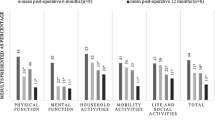Abstract
Objective The incidence of breast cancer related lymphedema (BCRL) varies between 7-35% depending on the combination of treatment modalities. Early detection of BCRL is crucial in order to start an effective non-operative treatment program. Because of the lack of prospective research on this topic, this study was undertaken to prospectively determine the effect of Lympho Venous Anastomosis (LVA) on BCRL and to review the current literature. Study design and methods Ten patients who were previously treated for breast cancer by surgery, radiotherapy, and chemotherapy, and were unresponsive to 12-weeks of non-operative treatment, underwent an LVA procedure (Degni-Cordeiro). Objective measurements were gathered for circumferential measurement and water volumetry, and quality of life. Various types of lymphoscintigraphy were carried out pre-operatively and post-operatively at 3 and 12 months. Treatment was embedded in a multidisciplinary setting. Results Post-operative volume measurements initially showed a 4.8% reduction of lymphedema at 3 months and a 2% reduction after one year. Various scintigraphic parameters showed some improvement. Quality of life questionnaires reported minimal improvement. Reviewing the literature, only retrospective studies were found; these reported varying results for LVA procedures. The selection of patients, classification of lymphedema, indications and types of LVA, and additional therapeutic options were heterogeneous, not comparable, and lacked a validated method of effect-assessment. Conclusions Our results showed a minimal reduction in volume of lymphedema following LVA; in the literature, there was no convincing evidence of the success of LVA. Non-operative treatment and elastic stockings are still preferred by most patients with lymphedema, especially in early stages with few irreversible changes.
Similar content being viewed by others
References
Brorson H, Ohlin K, Olsson G, Nilsson M (2006) Adipose tissue dominates chronic arm lymphedema following breast cancer: an analysis using volume rendered CT images. Lymphat Res Biol 4(4):199–210
Mortimer PS (1997) Therapy approaches for lymphedoedema. Angiology 48(1):87–91
O’Brien BM, Sykes PJ, Threlfall GN, Browning FS (1977) Microlymphaticovenous anastomoses for obstructive lymphedema. Plast Reconstr Surg 60(2):197–211
Campisi C, Boccardo F, Zilli A, Maccio A (2001) the use of vein grafts in the treatment of peripheral lymphedemas: long term results. Microsusrgery 21(4):143–147
Baumeister RGH, Frick A (1996) Die autogen gefasstransplantation zur microchirurgischen Rekonstruktion des Lymphgefassysteems. Phlebol 25:83–88
Aaronson NK, Muller M, Cohen PD, Essink-Bot ML, Fekkes M, Sanderman R, Sprangers MA, te Velde A, Verrips E (1998) Translation, validation, and norming of the Dutch language version of the SF-36 health survey in community and chronic disease populations. J Clin Epidemiol 51(11):1055–1068
Damstra RJ, Glazenburg E, Hol W (2006) The validation of the inverse water volumetry: New gold standard for arm volume measurement. Breast Cancer Res Treat 99(3):267–273
Herpertz U (1994) Messung und Dokumentation von Ödemen. Lymphologie 18:24–30
Vignes S, Boursier v, Priollet P, Miserey G, Trévidic P (2003) Quantitative evaluation and qualitative results of surgical lymphovenous anastomosis in lower limb lymphedema. J Mal Vasc 28(1):30–35
Kleinhans E, Baumeister RGH, Hahn D, Siuda S, Bull U, Moser E (1985) Evaluation of transport kinetics in lymphoscintigraphy: follow-up study in patients with transplanted lymphatic vessels. Eur J Nucl Med 10:349–352
Degni M (1981) New techniques of lymphatic-venous anastomosis for the treatment of lymphedema. Lymphlology 14(2):61–63
Brorson H (2003) Liposuction in arm lymphedema treatment. Scand J Surg 92(4):287–295
O’Brien BC, Shafiroff BB (1979) Microlymphaticovenous and resectional surgery in obstructive lymphedema. World J Surg 3(1):3–15
Filippetti M, Santoro E, Graziano F, Petric M, Rinaldi G (1994) Modern approaches to postmastectomy brachial lymphedema. Microsurgery 15(8):604–606
Cruchten LH van, Nieuborg L (1995) Diagnose en behandeling van lymfoedeem. Ned Tijdschr Geneeskd 138:653–657
Campisi C, Boccardo F, Alitta P, Tachella M (1995) Derivative lymphatic microsurgery: indications, techniques and results. Microsurgery 16(7):463–468
Huang GK (1989) Ergebnisse microchirurgischer lymphvenöser Anastomosen bei Lymphödemen Bericht über 110 Fälle. Langenbecks Arch Chir 374:194–199
Yamamoto Y, Sugihara T (1998) Microsurgical lymphaticovenous implantaton for the treatment of chronic lymphedema. Plast Reconstr Surg 101(1):157–159
Koshima I, Nanba Y, Tstsuya T, Takahahi Y, itoh S, Fujitsu M (2004) Minimal invasive lymphaticovenular anastomosis under local anesthesia for leg lymphedema. Is it effective for stage III and IV?. Ann Plast Surg 53:261–266
Matsubara S, Sakuda H, Nakaema M, Kuniyosh Y (2006) Long term results of microscopic lymphatic vessel isolated vein anastomosis for secondary lymphedema of the lower extremities. Surg Today 36:859–864
Campisi C, Davini D, Bellini C, Taddei G, Villa G, Fulcheri E, Zilli A, Da Rin E, Eretta C, Boccardo F (2006) Lymphatic microsurgery for the treatment of lymphedema. Microsurgery 26:65–69
Földi E, Földi M, Clodius L (1989) The lymphedema chaos: a lancet. Ann Plast Surg 22(5):148–151
Szuba A, Cooke JP, Youuf S, Rockson SG (2000) Decongestive lymphatic therapy for patients with cancer related or primary lymphedema. AM J Med 109:296–300
Campisi C, Eretta C, Pertile D, Dan Rin D, Campisi C et al (2007) Microsurgery for treatment of peripheral lymphedema: long term outcome and future perspectives. Microsurgery 27(4):333–338
Baumeister RG, Siuda S (1990) Treatment of lymphedemas by microsurgical lymphatic grafting: what is proved? Plast Reconstr Surg 85:64–76
Weiss M, Baumeister RGH, Hahn K (2002) Post-therapeutic lymphedema: scintigraphy before and after autologous lymph vessel transplantation; 8 years of long-term follow-up. Clin Nucl Med 27:788–792
Vaqueiro M, Gloviczki P, Fisher J, Hollier LH, Schirger A, Wahner HW (1986) Lymphoscintigraphy in lymphedema: an aid to microsurgery. J Nucl Med 27:1125–1130
Yuan Z, Chen L, Zhu J, Lu H, Zhu R (2006) The role of radionuclide lymphoscintigraphy in extremity lymphedema. Ann Nucl Med 20(5):341–344
Scarsbrook AF, Ganeshan A, Bradley KM (2007) Pearls and pitfalls of radionuclide imaging of the lymphatic system: part 2: evaluation of extremity lymphedema. Br J Radiol 80(951):219–226
Ketterings C, Zeddeman S (1997) Use of the C-scan in evaluation of peripheral lymphedema. Lymphology 30:49–62
Acknowledgements
Contributions R.J. Damstra was the lead author in the overall conceptualization and design of the study and the manuscript. He collected the data and prepared the databases. H.G.J Voesten participated in revising and editing the text. W.D. van Schelven participated in the design and the execution of the (semi) quantitative scintigraphic studies, as well as the analysis and the interpretation of the scans. He had the primary responsibility for the scintigraphic paragraphs. B. van de Lei performed all microsurgical procedures, participated in drafting the text and provided overall supervision of the manuscript.
Author information
Authors and Affiliations
Corresponding author
Rights and permissions
About this article
Cite this article
Damstra, R.J., Voesten, H.G.J., van Schelven, W.D. et al. Lymphatic venous anastomosis (LVA) for treatment of secondary arm lymphedema. A prospective study of 11 LVA procedures in 10 patients with breast cancer related lymphedema and a critical review of the literature. Breast Cancer Res Treat 113, 199–206 (2009). https://doi.org/10.1007/s10549-008-9932-5
Received:
Accepted:
Published:
Issue Date:
DOI: https://doi.org/10.1007/s10549-008-9932-5




